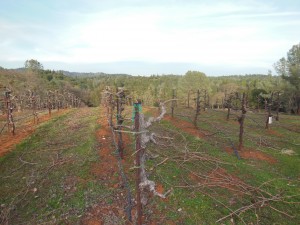With one month to go until the longest day of the year, things are getting under control in the vineyard, and it’s looking good. As always, April-May is a busy time, as the combination of rapid shoot growth of the vines and growth of our cover crop between rows has us running in all directions. Throw in firing up the irrigation system for the first time in months and chasing some unexpected deer intruders, and it’s been non-stop.
Shortly after the last update to this blog on the nights of April 16-17, we came very close to a frost event at a time when all the varietals had already pushed. Fortunately, it was apparently just warm enough to avoid frost in the vines, as we did not detect any damage. The news was not so good for a couple of apricot trees in our orchard, which look like they were nuked, and we’re still waiting to see if they bounce back.
The barbera was the first to bloom on Mother’s Day, May 12, and the other varietals followed within a week or so. Grape blooms are not showy, but the perfume-like odor is unmistakable and a rite of spring. Petiole sampling is typically done at this time, since there are historical data from prior years and reference databases with which to compare at this particular milestone. We did a little extra sampling of petioles this year in the barbera so that we could compare the nutritional status of different rootstock-clone combinations. The potential for such a comparison was always built into our vineyard design, but we haven’t looked specifically at nutritional status in the different blocks, and we’ll see what comes back.
With the help of ever-tapering amounts of spring rain–now probably done–we were able to hold off on our first irrigation until bloom. We hope to be able to water sparingly through veraison, but that will mainly be driven by the extent of the heat and resulting transpiration loss.
Based on signs that our use of a kicker cane for 3 years had helped sap some of the barbera vigor and brought the vines into better balance, we omitted the kicker cane this year, but did our suckering of abundant shoots in the barbera a little later than usual. The slight delay should have allowed the vine to expend some of its excess energy on shoots that were going to be removed anyway.
In our newer touriga block, we are planning an experiment to look at the effects of different fruit thinning practices on outcomes, and are hoping to dedicate 3 adjacent rows to this. If possible, we will not only look at such things as yield and grape chemistry, but also quality of resulting wines.
We are of course applying preventative treatments for powdery mildew at regular intervals at this time. Conditions have been near-perfect for mildew growth, with some summer-like heat early in May which has tapered to some very pleasant spring weather lately. However, pleasant to us means perfect for mildew, so we need to keep up with the regular spraying.
We blew the deadline for El Dorado County Fair wine entries, but have entered some homemade wines from our grapes in the Amador and Orange County fairs. In addition, Shaker Ridge is still accepting entries for our contest of best homemade wine made from our grapes (vintages 2010-2011-2012), based on public blinded tasting competition results. Please see our April blog for details. There is no cost and no obligation, and you can have a shot at 400 lbs of free grapes. Among competitions being considered for eligibility, Amador County Fair is still accepting entries through May 31.

